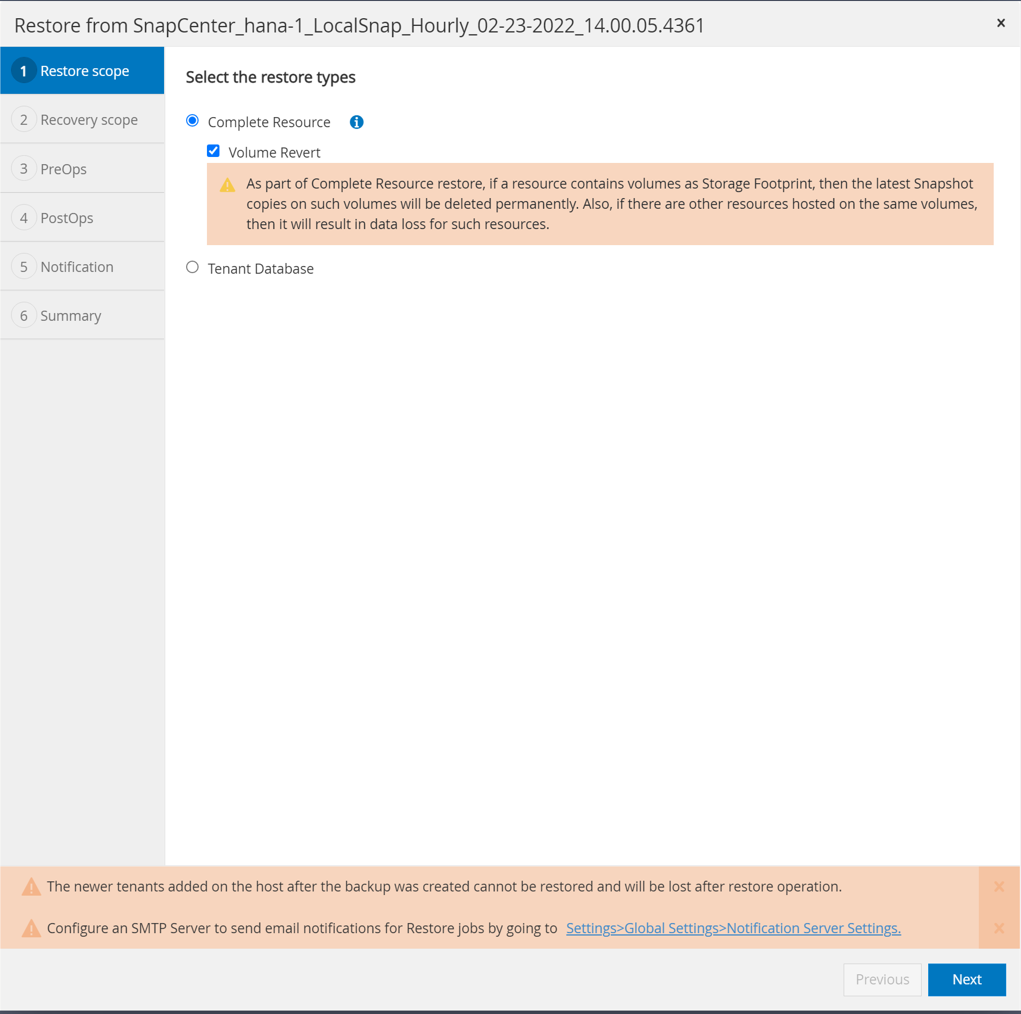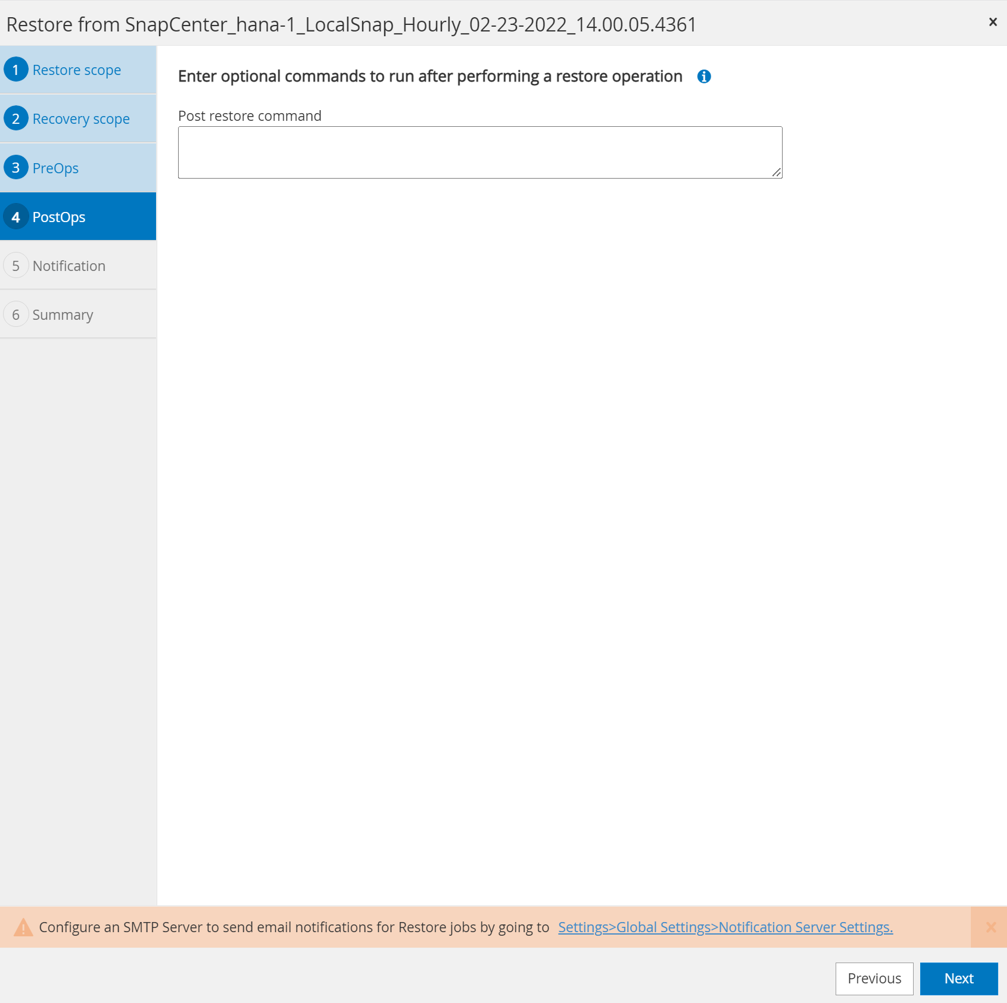Backup of non-data volumes
 Suggest changes
Suggest changes


The backup of non-data volumes is an integrated part of the SnapCenter and the SAP HANA plug-in.
Protecting the database data volume is sufficient to restore and recover the SAP HANA database to a given point in time, provided that the database installation resources, and the required logs are still available.
To recover from situations where other non-data files must be restored, NetApp recommends developing an additional backup strategy for non-data volumes to augment the SAP HANA database backup. Depending on your specific requirements, the backup of non-data volumes might differ in scheduling frequency and retention settings, and you should consider how frequently non-data files are changed. For instance, the HANA volume /hana/shared contains executables but also SAP HANA trace files. While executables only change when the SAP HANA database is upgraded, the SAP HANA trace files might need a higher backup frequency to support analyzing problem situations with SAP HANA.
SnapCenter non-data volume backup enables Snapshot copies of all relevant volumes to be created in a few seconds with the same space efficiency as SAP HANA database backups. The difference is that there is no SQL communication with SAP HANA database required.
Configure non-data volume resources
Follow these steps to configure non-data volume resources:
-
From the Resources tab, select Non-Data-Volume and click Add SAP HANA Database.

-
In step one of the Add SAP HANA Database dialog, in the Resource Type list, select Non- data Volumes. Specify a name for the resource and the associated SID and the SAP HANA plug-in host that you want to use for the resource, then click Next.

-
Add the SVM and the storage volume as storage footprint, then click Next.

-
To save the settings, in the summary step, click Finish.

The new non-data volume is now added to SnapCenter. Double click the new resource to execute the resource protection.

The resource protection is done in the same way as described before with a HANA database resource.
-
You can now execute a backup by clicking on Backup Now.

-
Select the policy and start the backup operation.

The SnapCenter job log shows the individual workflow steps.

The new backup is now visible in the resource view of the non- data volume resource.

Restore and recover
With SnapCenter, automated restore and recovery operations are supported for HANA single host MDC systems with a single tenant. For multiple-host systems or MDC systems with multiple tenants, SnapCenter only executes the restore operation and you must perform the recovery manually.
You can execute an automated restore and recovery operation with the following steps:
-
Select the backup to be used for the restore operation.
-
Select the restore type. Select Complete Restore with Volume Revert or without Volume Revert.
-
Select the recovery type from the following options:
-
To most recent state
-
Point in time
-
To specific data backup
-
No recovery
The selected recovery type is used for the recovery of the system and the tenant database.
-
Next, SnapCenter performs the following operations:
-
It stops the HANA database.
-
It restores the database. Depending on the selected restore type, different operations are executed.
-
If Volume Revert is selected, then SnapCenter unmounts the volume, restores the volume by using volume-based SnapRestore on the storage layer, and mounts the volume.
-
If Volume Revert is not selected, then SnapCenter restores all files by using single file SnapRestore operations on the storage layer.
-
-
It recovers the database:
-
By recovering the system database
-
recovering the tenant database
-
starting the HANA database
If No Recovery is selected, SnapCenter exits, and you must perform the restore operation for the system and the tenant database manually.
-
To perform a manual restore operation, follow these steps:
-
Select a backup in SnapCenter to be used for the restore operation.

-
Select the restore scope and type.
The standard scenario for HANA MDC single tenant systems is to use complete resource with volume revert. For a HANA MDC system with multiple tenants, you might want to restore only a single tenant. For more information about the single tenant restore, see Restore and recovery (netapp.com).

-
Select Recovery Scope and provide the location for log backup and catalog backup.
SnapCenter uses the default path or the changed paths in the HANA global.ini file to prepopulate the log and catalog backup locations.

-
Enter the optional pre-restore commands.

-
Enter the optional post-restore commands.

-
To start the restore and recovery operation, click Finish.

SnapCenter executes the restore and recovery operation. This example shows the job details of the restore and recovery job.




 Best Practices
Best Practices
